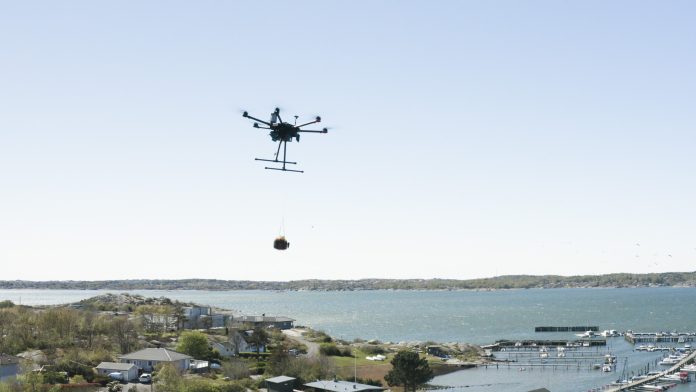Flying drones equipped with defibrillators to aid cardiac arrest patients are faster than ambulances in two out of three cases, according to a study published by The Lancet Digital Health.
Despite the installation of thousands of automatic external defibrillators in public places, such as shopping centres and libraries, the survival rate of cardiac arrest patients in Sweden remains the same as it has been ten years ago. Andreas Claesson, a paramedic for 25 years and an associate professor of emergency medicine at the university Karolinska Institutet in Stockholm, stated:
Most cardiac arrests happen at home. If we want to help more people survive, we need to help them more quickly on the spot.
The new approach of deploying drones was tested from April 2021 to May 2022 under real-life conditions in five semi-urban areas in the western region of Västra Götaland in Sweden, with a population of about 200,000 people.
In the case of an emergency service call, the drone received a message simultaneously with two ambulances. It automatically flew to the specified address, delivering a basket with a defibrillator. In almost all cases (91%), this life-saving device was winched down within 15 metres of a building door or patient.
However, the drones used by the Everdrone operator could not be used or deployed in windy, rainy or snowy weather and were sometimes hampered by flight restrictions.
The drones were used in 72 of 211 cases of suspected cardiac arrest during the study period. Of these, a defibrillator was safely delivered in 58 cases (in the remaining 14, the drones were recalled by the dispatch centre). Of these 58 cases, the drone outperformed ambulances 37 times (67%) with an average time of 3 minutes 14 seconds.
According to results recently published in The Lancet Digital Health, 18 of the 37 cases were true out-of-hospital cardiac arrests, with witnesses connecting defibrillators to 6 of these patients, one of whom survived for more than 30 days.
“I believe six out of 18 cases could be considered good because there may be people who don’t understand what to do or simply can’t do it.”
When the defibrillator is switched on, an automatic voice tells the spotter and dispatcher what to do. Once the defibrillator is properly attached to the patient, it uses an ECG electrocardiogram to analyse the heart’s electrical signals and detect any heart problems.
Sometimes the heart may have stopped beating, with no activity. Then, there is no point in using the defibrillator. Instead, the device can advise bystanders on how to perform chest compressions.
One of the options is to connect drones to the Sms-livräddare (mobile SMS rescue) network, where volunteer rescuers trained in heart and lung salvage can be alerted when someone calls 112 and a call centre suspects cardiac arrest.
“We now know that we have a transport system that works. It can also be used for other medical purposes, to deliver an auto-injector of adrenaline in case of an allergic reaction, a naloxone spray in the case of a drug overdose or a trauma dressing in the case of a shooting or a traffic accident.”
According to the network, about 350,000 people in Europe suffer out-of-hospital cardiac arrest each year, with only about 10 per cent surviving.
The region and Norway are currently conducting another drone trial with funding from the EU’s Interreg programme. Magnus Kristiansson, the region’s project manager, said:
The drones that have cameras fly out to traffic or other accidents where the emergency centre needs to film and monitor the situation.
Operator Everdrone plans to invest in the next generation of drones that can fly in rainy weather and over long distances.
“We see this as a technical element that we can use in many future scenarios. Not only to deliver defibrillators but also to create equal care, even for those who live on islands near our costs, for example.”
In addition, EENA, the European Emergency Number Association, is actively involved in developing the use of drones in emergency situations, including testing the use of AED-equipped UAVs in Sweden in 2021, according to its Executive Director Gary Machado.
We concluded that UAV AED delivery is showing great potential as a way to improve OHCA survival rates, and we are pleased to see this technology expanded to other life-saving medical treatments and look forward to the possibilities this will bring for public safety in Europe.
